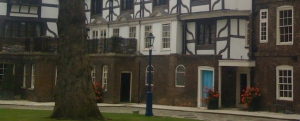 Seven years ago I stumbled across a book mis-catalogued by the British Library, or rather its predecessor the British Museum Library. Intriguingly, it connected a prominent ancestor, Sir John Glanvill (pictured), with imprisonment in the Tower of London in the 1640s and offered possible answers to other passages in his life story.
Seven years ago I stumbled across a book mis-catalogued by the British Library, or rather its predecessor the British Museum Library. Intriguingly, it connected a prominent ancestor, Sir John Glanvill (pictured), with imprisonment in the Tower of London in the 1640s and offered possible answers to other passages in his life story.
The book had been indexed as ‘J. G. Canoyle’ but I indulged my hunch and was thrilled to be vindicated when I viewed it. Sure enough, the cover read: ‘a Paraphrase uppon the Psalms of David by Sir [crossed out] John Glanvill knight, one of the King’s Serjeants at Law, late Speaker of the comons house of Parliament.’ I found a date – 10 January 1645 (old style, so 1646 by today’s calendar) – and saw it had been purchased at Sotheby’s in 1881.
Glanvill, the son of a circuit judge, was an influential political figure in the first half of the C17th. I already knew he had married Winifred Bourchier in 1615 and that they had had seven children who reached adulthood. As an MP and lawyer records suggested he had embraced social reform, opposing rotten boroughs and King Charles I’s excessive tax-raising schemes. Although he lived the high life he did not appear anti-Puritan.
Yet, puzzlingly, when civil war came he first brokered for peace, then sided with the King and was eventually imprisoned as a traitor by Parliament. Diarist John Evelyn claimed John had even burned down his mansion in Broad Hinton, Wiltshire, to prevent it being garrisoned by Cromwell’s forces.
These events are reasonably well documented though not explained. But a lengthy note in the book of psalms – a primary source gift to any family historian – would add compelling detail to his story.
The handwritten note is at various times a dedication to his ‘loving wief’ Winifred, a biography, a plea for deliverance, and a chronology of his psalm-rewriting.
The latter reveals that among his sources for David’s psalms were the bible versions of King James and ‘Mr Calvin’. Calvin’s reformed protestant views were shared by Parliament rather than Charles I and his Archbishop, Laud. John’s cousin, Joseph Glanvill, was also a noted Christian philosopher and sceptic, and the family was far from being High Church, pro-Catholic, so there is a further puzzle over his civil war leaning.
In one passage John describes: ‘the losse of my chief mansion house of Brodehinton [Broad Hinton] in Wilteshire, burned down by a comanded partie of the King’s forces in may last [1645], alleadyng for there reason that they did it only to prevent the Parliament forces of making it a garrison for there service’ – a crucially different take on the event to Evelyn’s, and hardly likely to enamour him to Charles. Perhaps he had been promised favours; perhaps he had no faith in a republic.
John goes on to describe ‘the late death of two of our sons, young men, in the flower of there age: the dangerous sickness from which I am not yet fully recovered: and the long imprisonment of my person which still continueth.’
The first point about sons recently dead led was intriguing. I knew of one – Francis Glanvill, a long-serving professional officer in the King’s army, slain at the siege of Bridgewater six months before the note was written. All other sons recorded lived beyond 1645, setting me off to discover another. Eventually I found Walter Glanvill, son of John and Winnifred, in the St Dunstan-in-the-West parish register, baptised 24 Feb 1623. It remains to be seen whether he died in the 1640s.
The recurring ‘dangerous sickness’ was probably what saw John off in October 1661. He had complained about it confining him to bed as early as 1626; one possibility I am exploring is that it was malaria, and there are tantalising hints that he traveled widely through his commercial and legal work.
The chronology of John’s imprisonment is laced through the text: ‘being taken prisoner and so carried to Oxford [after July 1643] where I long remained under the restraint of a command in the tyme of these unaturall civil warrs’, and ‘here [ie the Tower] where I am now a prisoner and have so bin ever since the 20th of June 1644… ‘.
His ‘cell’, I was advised, would have been in one of the pleasant buildings adjacent to the Beauchamp tower in the inner ward. The note in the book of psalms signs off, ‘Tower of London, 10th day of January, 1645.’
John was eventually released after four years in the Tower in 1648. He was forced to surrender rents from his various properties to make up a fine of £2,320 (over a quarter of a million in today’s money) for his High Treason, but was briefly restored to the position of King’s Serjeant on the restoration of the monarchy.
The recent chance discovery of a handwritten book of psalms still provides clues to put flesh on the bones of this ancestor from four centuries ago. Further proof that the evidence is out there: you just need to know where to look.

